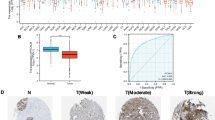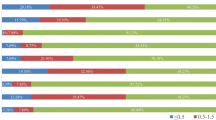Abstract
Parkinson’s disease is associated with DJ-1/Parkinson protein 7 dysfunction. In contrast, hyperactivity of DJ-1 increases the resistance of cancer cells to apoptosis. Recent genetic studies showed that, in addition to apoptosis pathways, DJ-1 is also involved in cellular defense against reactive oxygen species. The activity of apoptotic and cellular defense pathways is key in determining drug sensitivity. DJ-1 overexpression is associated with various cancers. However, we previously found that there were approximately 50 % patients with breast cancers that expressed low levels of DJ-1 protein, despite mRNA upregulation. Furthermore, low DJ-1 expression was a significant predictor of poor clinical outcome in these patients. This study aimed to determine the association between low DJ-1 protein expression and pathological complete remission (pCR) after neoadjuvant chemotherapy in breast cancer patients. Expression of DJ-1 in pre-therapeutic needle biopsies and surgical specimens obtained from 205 breast cancer cases that received neoadjuvant chemotherapy was determined using immunohistochemistry and in situ hybridization. Chemotherapy comprised epirubicin/cyclophosphamide taxane-based regimens with or without the inclusion of trastuzumab. Univariate and multivariate analyses were used to evaluate the predictive value of DJ-1 on pCR. Low DJ-1 protein expression was detected in 45.3 % (93/205) of all breast cancer cases and in 79.6 % (39/49) of pCR cases, irrespective of maintained mRNA levels. DJ-1 expression [hazard ratio (HR): 1.36; 95 % confidence interval (CI): 1.01–1.84] and HER2 status (HR: 0.84; 95 % CI: 0.62–1.14), in contrast to histological grade, hormone receptors status, Ki-67 labeling index, and intrinsic subtype, were significant predictors of pCR. Low DJ-1 expression predicted pCR in luminal A (P = 0.0004), luminal B (P = 0.0194), and triple negative (P = 0.0143) subtypes breast cancer patients and in patients receiving additional trastuzumab treatment (P = 0.008). In conclusion, low DJ-1 protein expression is a significant predictor of pCR after neoadjuvant chemotherapy in breast cancer patients.

Similar content being viewed by others

References
Gonzalez-Angulo AM, McGuire SE, Buchholz TA, Tucker SL, Kuerer HM, Rouzier R et al (2005) Factors predictive of distant metastases in patients with breast cancer who have a pathologic complete response after neoadjuvant chemotherapy. J Clin Oncol 23:7098–7104
Jeruss JS, Mittendorf EA, Tucker SL, Gonzalez-Angulo AM, Buchholz TA, Sahin AA et al (2008) Combined use of clinical and pathologic staging variables to define outcomes for breast cancer patients treated with neoadjuvant therapy. J Clin Oncol 26:246–252
Rastogi P, Anderson SJ, Bear HD, Geyer CE, Kahlenberg MS, Robidoux A et al (2008) Preoperative chemotherapy: updates of National Surgical Adjuvant Breast and Bowel Project Protocols B-18 and B-27. J Clin Oncol 26:778–785
Caudle AS, Gonzalez-Angulo AM, Hunt KK, Liu P, Pusztai L, Symmans WF et al (2010) Predictors of tumor progression during neoadjuvant chemotherapy in breast cancer. J Clin Oncol 28:1821–1828
von Minckwitz G, Untch M, Blohmer JU, Costa SD, Eidtmann H, Fasching PA et al (2012) Definition and impact of pathologic complete response on prognosis after neoadjuvant chemotherapy in various intrinsic breast cancer subtypes. J Clin Oncol 30:1796–1804
Sotiriou C, Pusztai L (2009) Gene-expression signatures in breast cancer. N Engl J Med 360:790–800
Mohsin SK, Weiss HL, Gutierrez MC, Chamness GC, Schiff R, Digiovanna MP et al (2005) Neoadjuvant trastuzumab induces apoptosis in primary breast cancers. J Clin Oncol 23:2460–2468
Nagakubo D, Taira T, Kitaura H, Ikeda M, Tamai K, Iguchi-Ariga SM et al (1997) DJ-1, a novel oncogene which transforms mouse NIH3T3 cells in cooperation with ras. Biochem Biophys Res Commun 231:509–513
Vasseur S, Afzal S, Tomasini R, Guillaumond F, Tardivel-Lacombe J, Mak TW et al (2012) Consequences of DJ-1 upregulation following p53 loss and cell transformation. Oncogene 31:664–670
Kim RH, Peters M, Jang Y, Shi W, Pintilie M, Fletcher GC et al (2005) DJ-1, a novel regulator of the tumor suppressor PTEN. Cancer Cell 7:263–273
Junn E, Taniguchi H, Jeong BS, Zhao X, Ichijo H, Mouradian MM (2005) Interaction of DJ-1 with Daxx inhibits apoptosis signal-regulating kinase 1 activity and cell death. Proc Natl Acad Sci USA 102:9691–9696
Sekito A, Koide-Yoshida S, Niki T, Taira T, Iguchi-Ariga SM, Ariga H (2006) DJ-1 interacts with HIPK1 and affects H2O2-induced cell death. Free Radic Res 40:155–165
Le Naour F, Misek DE, Krause MC, Deneux L, Giordano TJ, Scholl S et al (2001) Proteomics-based identification of RS/DJ-1 as a novel circulating tumor antigen in breast cancer. Clin Cancer Res 7:3328–3335
Liu H, Wang M, Li M, Wang D, Rao Q, Wang Y et al (2008) Expression and role of DJ-1 in leukemia. Biochem Biophys Res Commun 375:477–483
Chen Y, Kang M, Lu W, Guo Q, Zhang B, Xie Q et al (2012) DJ-1, a novel biomarker and a selected target gene for overcoming chemoresistance in pancreatic cancer. J Cancer Res Clin Oncol 138:1463–1474
Tsuchiya B, Iwaya K, Kohno N, Kawate T, Akahoshi T, Matsubara O et al (2012) Clinical significance of DJ-1 as a secretory molecule: retrospective study of DJ-1 expression at mRNA and protein levels in ductal carcinoma of the breast. Histopathology 61:69–77
Sobin LH, Wittekind C (2002) TNM classification of malignant tumours, 6th edn. In: Breast tumours. Wiley-Liss, New York, p 131–141
Hiroi S, Nakanishi K, Kawai T (2003) Expressions of human telomerase mRNA component (hTERC) and telomerase reverse transcriptase (hTERT) mRNA in effusion cytology. Diagn Cytopathol 29:212–216
Lakhani SR, Ellis IO, Schnitt SJ, Tan PH, Van de Vijver MJ (2011) The World Health Organization classification of tumours of the breast, 4th edn. In: Special subtypes. World Health Organization, Lyon, p 39–76
Elston CW, Ellis IO (1991) Pathological prognostic factors in breast cancer. The value of histological grade in breast cancer: experience from a large study with long-term follow-up. Histopathology 19:403–410
Allred DC, Harvey JM, Berardo M, Clark GM (1998) Prognostic and predictive factors in breast cancer by immunohistochemical analysis. Mod Pathol 11:155–168
Wolff AC, Hammond ME, Schwartz JN, Hagerty KL, Allred DC, Cote RJ (2007) American Society of Clinical Oncology/College of American Pathologists guideline recommendations for human epidermal growth factor receptor 2 testing in breast cancer. J Clin Oncol 25:118–145
Goldhirsch A, Wood WC, Coates AS, Gelber RD, Thürlimann B, Senn H-J et al (2011) Strategies for subtypes―dealing with the diversity of breast cancer: highlights of the St. Gallen international expert consensus on the primary therapy of early breast cancer 2011. Ann Oncol 22:1736–1747
Ismail IA, Kang HS, Lee HJ, Kwon BM, Hong SH (2012) 2’-Benzoyloxycinnamaldehyde-mediated DJ-1 upregulation protects MCF-7 cells from mitochondrial damage. Biol Pharm Bull 35:895–902
Zhou W, Freed CR (2005) DJ-1 up-regulates glutathione synthesis during oxidative stress and inhibits A53T alpha-synuclein toxicity. J Biol Chem 280:43150–43158
Clements CM, McNally RS, Conti BJ, Mak TW, Ting JP (2006) DJ-1, a cancer- and Parkinson’s disease-associated protein, stabilizes the antioxidant transcriptional master regulator Nrf2. Proc Natl Acad Sci USA 103:15091–15096
Rushworth SA, Zaitseva L, Murray MY, Shah NM, Bowles KM, Macewan DJ (2012) The high Nrf2 expression in human acute myeloid leukemia is driven by NF-κB an underlies its chemo-resistance. Blood 120(26):5188–5198
Homma S, Ishii Y, Morishima Y, Yamadori T, Matsuno Y, Haraguchi N et al (2009) Nrf2 enhances cell proliferation and resistance to anticancer drugs in human lung cancer. Clin Cancer Res 15:3423–3432
Zeng HZ, Qu YQ, Zhang WJ, Xiu B, Deng AM, Liang AB (2011) Proteomic analysis identified DJ-1 as a cisplatin resistant marker in non-small cell lung cancer. Int J Mol Sci 12:3489–3499
Kim YC, Kitaura H, Taira T, Iguchi-Ariga SM, Ariga H (2009) Oxidation of DJ-1-dependent cell transformation through direct binding of DJ-1 to PTEN. Int J Oncol 35:1331–1341
He XY, Liu BY, Yao WY, Zhao XJ, Zheng Z, Li JF et al (2011) Serum DJ-1 as a diagnostic marker and prognostic factor for pancreatic cancer. J Dig Dis 12:131–137
Tian M, Cui YZ, Song GH, Zong MJ, Zhou XY, Chen Y et al (2008) Proteomic analysis identifies MMP-9, DJ-1 and A1BG as overexpressed proteins in pancreatic juice from pancreatic ductal adenocarcinoma patients. BMC Cancer 8:241–252
Oda M, Makita M, Iwaya K, Akiyama F, Kohno N, Tsuchiya B et al (2012) High levels of DJ-1 protein in nipple fluid of patients with breast cancer. Cancer Sci 103:1172–1176
Fan J, Ren H, Fei E, Jia N, Ying Z, Jiang P et al (2008) Sumoylation is critical for DJ-1 to repress p53 transcriptional activity. FEBS Lett 582:1151–1156
Hinkle DA, Mullett SJ, Gabris BE, Hamilton RL (2011) DJ-1 expression in glioblastomas shows positive correlation with p53 expression and negative correlation with epidermal growth factor receptor amplification. Neuropathology 31:29–37
Marcondes AM, Li X, Gooley TA, Milless B, Deeg HJ (2010) Identification of DJ-1/PARK-7 as a determinant of stroma-dependent and TNF-alpha-induced apoptosis in MDS using mass spectrometry and phosphopeptide analysis. Blood 115:1993–2002
Acknowledgments
We thank Ms. Kozue Suzuki for technical assistance and Ms. Miho Morita for secretarial assistance. This study was supported by the Foundation for Promotion of Cancer Research (Keiichi Iwaya, and Osamu Matsubara), Ministry of Defense Grants (Keiichi Iwaya and Osamu Matsubara), Grant-in-aid for Scientific Research (KAKENHI24590457) (Keiichi Iwaya), and the National Cancer Research and Development Fund (23-A-11) (Keiichi Iwaya).
Conflict of interest
The authors declare that they have no conflicts of interest.
Author information
Authors and Affiliations
Corresponding author
Rights and permissions
About this article
Cite this article
Kawate, T., Iwaya, K., Kikuchi, R. et al. DJ-1 protein expression as a predictor of pathological complete remission after neoadjuvant chemotherapy in breast cancer patients. Breast Cancer Res Treat 139, 51–59 (2013). https://doi.org/10.1007/s10549-013-2523-0
Received:
Accepted:
Published:
Issue Date:
DOI: https://doi.org/10.1007/s10549-013-2523-0



